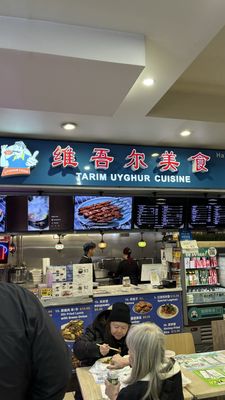New world Uyghur Cuisine
Uyghur eatery: lamb kebabs, noodle soups, pastries, pilaf
Uyghur eatery: lamb kebabs, noodle soups, pastries, pilaf


























"This food stall inside the New World Mall food court in Flushing serves pretty much every Uyghur staple - from rice and noodles to samsas. But the one thing you have to get here is the aluminum foil-wrapped kebabs. The foil acts almost like a little sleeping bag, keeping all the juices, cumin, and chili flakes packed in with the meaty kebabs. Make sure to try their lamb soup too, which comes with a small lamb shank and a broth full of carrots and spinach, topped with lots of cilantro." - jiniya azad, tahirah baksh, sameen choudhry

"Prominently located in the New World Mall’s basement food court, Tarim offers a very full Uyghur menu despite occupying only a small counter. Triangular, lamb-stuffed samsas, round flatbreads, and other pastries that change by the day are displayed on that counter, while an illuminated sign above offers lamb kebabs, chicken and lamb versions of dapan ji, the hand-pulled noodles known as lagman, and Uyghur pilaf, which is similar to Uzbek plov, though usually with a greater range of vegetables besides carrots and chiles." - Robert Sietsema


"This food stall inside the New World Mall food court in Flushing serves pretty much every Uyghur staple - from rice and noodles to samsas. But the one thing you have to get here is the kebabs, which come wrapped inside aluminum foil. The aluminum foil acts almost like a little sleeping bag, keeping all the juices, cumin, and chili flakes packed in with the meaty kebabs. Make sure to try their lamb soup too - it comes with a small lamb shank and a broth full of carrots and spinach, topped with lots of cilantro." - Jiniya Azad, Tahirah Baksh & Sameen Choudhry


"In the New World Mall food court, Tarim Uyghur Cuisine offers a compact 12‑item menu centered on dapanji (big tray chicken) and an especially memorable big tray lamb: not laced with Sichuan peppercorns and not very spicy overall, though fresh green peppers add a bite while red bell peppers are sweet; the lamb version totally rocks with stout wheat noodles and big fatty hunks of lamb — so lamb‑y it feels almost animal‑close. The rest of the menu balances kebabs and lagman with salads like bean jelly and chicken salad that remind me of Tibetan cooking." - Robert Sietsema